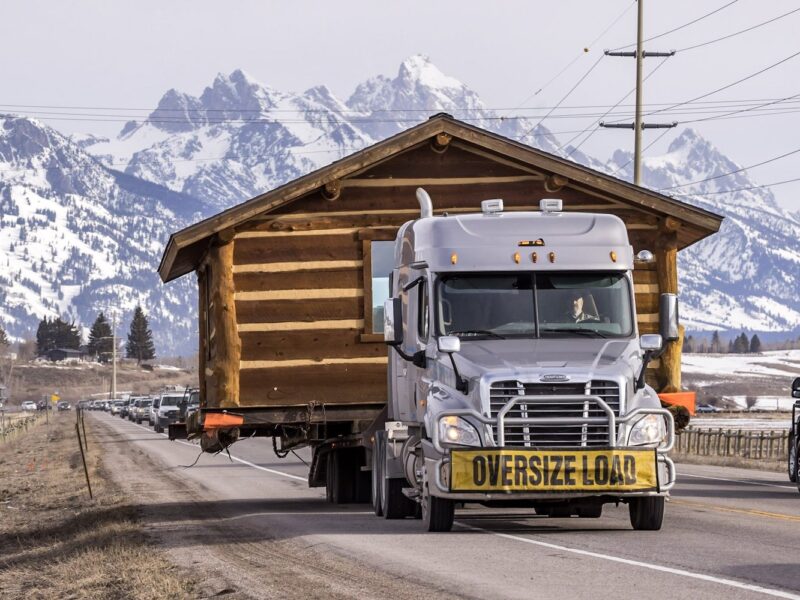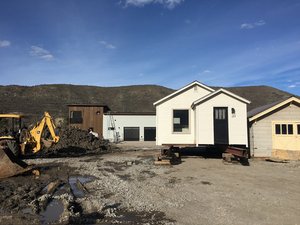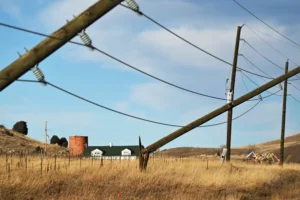Making It Work: A Novel Approach to Jackson’s Housing Shortage
Shacks on Racks saves historical buildings and moves them to create more affordable homes
- Published In: Other News & Features
- Last Updated: Apr 18, 2022

Esther Judge-Lennox, founder of Shacks on Racks, learned the owners of this 342-square-foot log cabin wanted to donate it. She identified and worked with new owners to move the cabin to Victor, Idaho. (Photo by Joey Sackett)
By Madeline Thulin
Special to the Wyoming Truth
What do you do when you can’t afford to buy a house in Jackson Hole, one of the most expensive places to live in the country?
Well, you could live in one of the surrounding areas and commute up to two hours each way through the dangerous Snake River Canyon or Teton Pass. Or, perhaps you could attempt to rent a place, along with a bunch of roommates. But here’s another idea: You could buy a parcel of land and essentially lift a more affordable house from somewhere in the Jackson area, put it on a truck and transport it to somewhere else in the region, including even Idaho. It’s an option offered by Shacks on Racks, a nonprofit that saves old buildings from demolition and moves them in the hopes of creating more affordable housing.
Best part? If you move your house with Shacks on Racks, the firm won’t charge a dime. Shacks on Racks will find you a house and help navigate the moving process, including what permits to obtain, pay for hookups to water, electric, sewer and how to arrange a police escort while the house is being moved. While the homeowner pays for the truck and associated moving cost, Shacks on Racks has had no costs, except for Esther’s time and effort. But that’s changing now as the firm just hired its first employee whose salary is being paid out of Esther’s husband’s pocket from the two family businesses they run together.

Well known among locals is that it’s hard to make ends meet in Jackson, given the astronomical cost of the limited housing. Service workers who play a key role in the area’s vital tourism industry are being pushed out of the valley due to high housing prices—and living expenses. The town and county governments, meanwhile, are working on ever-creative approaches to provide housing for those who need it.
What’s happening in Jackson is, in many ways, a microcosm of a broader divide in society between the haves and have nots; indeed, Jackson has been the subject of many commentaries about the stark economic divisions, including the nonfiction work, Billionaire Wilderness: The Ultra-Wealthy and the Remaking of the American West, a report by the Economic Policy Institute. And yet, the irony is that many aspiring Jackson residents flock to the area come anyway, seeking to enjoy the pristine wilderness and two national parks.
Esther Judge-Lennox was one of those folks once. In 1999, she moved to Jackson from the poor, rural town of Dillon, Montana. She grew up with construction in her family; her dad, Andrew Judge, erected the main house at the Circle S Ranch, a ranch just outside Jackson, and later founded two local businesses, including Gus the Gutterman, a gutter cleaning service, and Full-House Radon Services, which measures cancer-creating radon leaking from granite in houses. When she was eleven, Esther witnessed a 1906 house moved from Red Rock Ranch in southwestern Montana, owned by noted entrepreneur and philanthropist Ted Turner, to Dylan, Montana. That’s when she had an epiphany: “I knew from that point on that I could always have security with housing.”
Flash forward to 2016, over 20 years later, and Esther found herself observing a 1941 Craftsman home with beautiful bull-nosed sides and open rafters scheduled to be demolished in downtown Jackson. “It broke our hearts,” Esther said.
It also served as the inspiration for Esther’s new calling. Along with her husband Philip Lennox and son Silas Judge-Bauer, Esther was given the house by the owner, and she moved the house to somewhere else in Jackson where, she said, it “sat on the driveway on stilts until we could save enough money to move it onto a foundation.” Esther recalled, “I didn’t know we could save the house [and this was] the first moment of Shacks on Racks.”
Esther started attending Teton County Preservation meetings, which handled demolition permits and the preservation of historically significant buildings. She learned that if a building is scheduled for demolition but is also deemed historically significant, ninety days must elapse before the building is demolished. That mean one thing to Esther: She had ninety days to save each of these historically significant buildings.
“Shacks [on Racks] started to save houses from the trash,” Esther said.
Esther analyzes the characteristics of each house she is considering and matches it with potential owners who have already indicated that they are interested in acquiring a historically significant house for free, knowing that they will likely have to fix it up. Since 2003, about 5%-8% of the town’s historical buildings, which are scheduled for demolition, are reused and relocated for new homeowners and organizations.
Esther isn’t the only one moving houses in Jackson. “There are so many houses that have been moved” around Jackson, Esther said. “It would shock you how many houses have been moved.”
Esther said she plans to switch to a for-profit model later this year; she said it would help ease the number of regulations involved in moving houses.
In the six years since the creation of Shacks on Racks, Esther has only earned $24,800; that’s all come from donation from homeowners whom she’s helped. “This is my life,” she said. “… People pay to put their house in the trash. I need to convince the entire industry to…save on sight.”













